|
From Farm To Store
Submitted by Kim Grace/Written by Emory Bewley
Recently, I spoke to the Tigers at Boy Scout Pack 98 in Harford, Pa. I discussed the process milk goes through before it reaches the store and the different types of milk available.
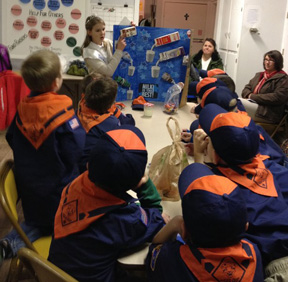
Emory Bewley, Dairy Ambassador with the Susquehanna County Dairy Promotion program. She is 12-years-old and in sixth grade at the Mountain View Elementary School.
First, I talked to them about milk fresh from the cow before it is pasteurized and homogenized. I explained to them that the cream in the milk separates, because it is lighter. Milk that isn’t homogenized needs to be shaken to mix the cream back into the milk. Farmers send their milk to a processing plant to go through homogenization, which is the process by which the fat globules are broken down and the cream does not float to the top of the milk. The milk processor puts the milk through super small holes to break up the fat. Finally, pasteurization heats up the milk to 161 degrees for 15 seconds and kills any bacteria that may be present. The finished product is ready to be bottled as whole milk. The milk also may go through another process to reduce the butterfat or add flavoring like strawberry.
Next I spoke to the Tigers about the different kinds of milk available in stores. I emphasized that whole milk is about 96% fat free and it’s my favorite of all milks available. Other choices in the grocery store are 2% milk (98% fat free), 1% lowfat milk (99% fat free), skim or fat-free milk and flavored milks, like chocolate.
Finally all the boys got to taste the delicious milk, which was served with cubed cheese. They loved the tasty snack. That’s two of their 3-A-Day dairy products. Now that is awesome.
Back to Top
Master Gardeners Present Program To Blue Ridge
Submitted by Kim Grace
The Penn State Master Gardeners of Susquehanna County recently presented a fun, educational “Poison Prevention” program to Blue Ridge Elementary School 1st and 2nd graders.
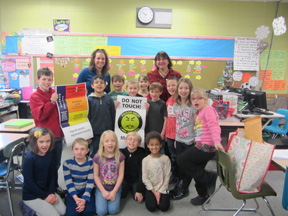
Pictured (l-r) are: front row - Alivia Gerba, Patrick Snyder, Shelby Fenton, Jayden Gregory, Angelina Slater; back row - Logan Sellito, Penn State Extension educator and mom Michelle Kowalewski, Josue Tobon, Max Kesinich, Andrew Kowaleski, Janna Weed, Master Gardener Cheryl Matulevich, Dawson Stepniak, Logan Haley, Emily McCarthy, Nevaeh Hunsinger.
The program teaches students about Mr. Yuk, poison look-alikes and identifying poison risks and safety measures. The Master Gardeners, led by Cheryl Matulevich present this program during the month of March to Susquehanna County 1st graders through a grant from the Penn State Pesticide Education Department.
Back to Top
SCDA Reorganizes
Submitted by Nancy Narma
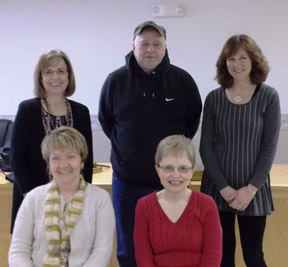
Pictured (l-r) are newly elected members of the Susquehanna Community Development Association (SCDA): standing, Darlene Slocum, John Sholtiss, Margaret Biegert; seated are Carol Newman and Judy Rood. Absent when photo was taken were Alice Deutsch and Gloria Biegert. Using the theme of “Put Susquehanna Back in Business”, the board has several events in the works for this year, starting with an Easter Egg Hunt later this month and including “Hometown Days” among others. If you would like to become involved in this very worthwhile organization, please contact any of the board members for further information.
The Board gathered recently for a Reorganization Meeting and have appointed the following officers for 2015-2016: Chairman Alice Deutsch, and Secretary/Treasurer Darlene Slocum will be working side by side with existing Board Members, Margaret Biegert, Gloria Biegert, and John Sholtiss, who also welcome new Board Members Judy Rood and Carol Newman.
Back to Top
Blue Spruce Trees Are In Decline
Submitted by Robert Wagner
Have you noticed the Colorado blue spruce that are losing their needles, some with entire portions of their branches completely bare? I am not talking about the old Christmas tree that may be in your back yard or somewhere else. I am talking about midlife to mature blue spruce trees, with distinctively blue-green needles, ones that are 30 to 60’ tall.
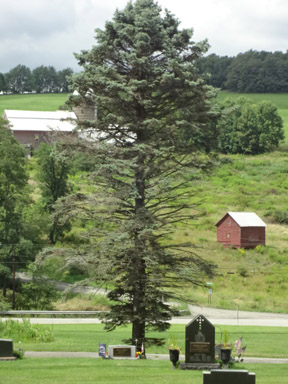
A Blue Spruce Tree from the west Montrose Area
Last summer, around Harford Fair time, DCNR Service Forester Ryan Brown and I were working with members of the Susquehanna County Forest Land Owners Association (SCFLOA), collecting wood samples and looking for interesting “things”. I asked Ryan what was the matter with some of these blue spruce trees that we were passing by just west of Montrose. His experienced eye said that the trees were infected with “rhabodecline” or needlecast. He said, “… there are several kinds of needlecast that infect/bother blue spruce - Rhabdocline pseudotsugae and R. weirii. Colorado blue spruce are more susceptible to this type of disease than are other types of spruce trees.” When the tree becomes less healthy it becomes more susceptible to diseases. Brown also added “… blue spruce seems to be suffering the most from needle cast because it is not a native tree species to PA and does not do as well with our humid climate. Spruce trees do not have a deep rooting system and compiled stress factors usually lead to death.” The normal lifespan for Colorado blue spruce, in the home landscape, is usually about 40 to 60 years, after which its health begins to fail.
What is happening to these trees? According to Penn State University Professor of Plant Pathology Gary Moorman, “Needlecast diseases of evergreens are caused by several fungi. Needles infected with fungi generally fall several months after the actual period of infection. The period of greatest infection for most needlecast fungi is during the late spring and early summer months. Symptoms, the visible indications that the needle is diseased, do not appear until the late winter, spring, and early summer of the next year.
All the needlecast fungi form small structures on the infected needle in which thousands of spores form. These "fruiting structures" may be black, orange-red, or tan, depending upon the fungus. Other fungi that grow on dead or dying needles, but do not cause needlecast may form similar structures. Finding a fungal fruiting structure on a dead needle is not proof that the tree has a needlecast disease.”
How do you manage this disease? Needlecast fungi require abundant moisture for their growth and development. Avoid planting susceptible trees in low or shady areas where humidity and needle wetness tends to be high for prolonged periods. Smaller trees could be treated with fungicides, which Christmas tree growers use when their trees appear to have needlecast. Larger trees that are infected rarely recover from needlecast.
SCFLOA Board member Jim Kessler also notes “…Blue spruce commonly have two (other) problems. They are infected with ‘’’Cytospora’’’ canker and ‘’’Spider mites’’’. These spider mites are a native mite, almost like an insect. Miticide helps treat the spider mite problem. (The cytospora canker harbors a fungus which attacks trees or parts of trees that are injured or in a weak or stressed condition. The fungus grows in the living bark and wood and kills by girdling the branch or tree.) Sanitation (cutting and burning) helps with all these issues.” Mr. Kessler further explained that while “… Rhabdocline needlecast is a disease of Douglas fir, Colorado blue spruce is an alternate host.”
What do you do with the large trees that are infected? DCNR Service Forester Brown suggests, “These trees should be cut down and all of the infected parts should be burned. If you leave the trees and limbs lying about they can be hosts for other tree diseases.”
What about replanting? Brown further stated that he, “… would not recommend continued planting of blue spruce but if a person must have these trees, keep them in a drier area and away from hardscape. (Hardscape, in the practice of landscaping, refers to built environment including paved areas like streets & sidewalks, structures, walls, street amenities, pools and fountains, and fireplaces and firepits.) It would be a good idea to plant white spruce or our naturalized friend, Norway spruce. Plant so that the air circulation around trees will be good.”
SCFLOA encourages you to take a good look at your blue spruce trees now and in the next few weeks. If your trees look like the ones that are shown with this article, it is time to cut those blue spruce trees down and properly dispose of them. Do not just leave them lying on the ground.
Back to Top
SCDA Gearing Up
Submitted by Nancy Narma
With Spring right around the corner, the Board Members of the Susquehanna Community Development Association have met and are preparing for another year of working hand in hand with local, regional and state agencies to plan, promote, and communicate that not only is the Susquehanna Community Development Association open to ideas and suggestions, but, is ready, with arms stretched wide, to welcome new businesses, as well as being instrumental in assisting existing businesses in our area. Everyone needs a helping hand now and then, and the S.C.D.A. is more than willing to answer questions and give the guidance that is needed. 2014 was a super busy year for the Association and indications are that 2015 promises to have just as full a schedule, if not more.
Summertime will welcome “Hometown Days”—those sun-filled days of fun for all ages, from the opening parade to the final burst of fireworks. Last year’s “Hometown Days” welcomed the birth of the “5K Run” which culminated in a great success with over 100 runners participating. It is our fervent hope that even more runners will join in the event this year. Plans to expand “Hometown Days” are underway, with talk of an additional day of festivities, more rides and, perhaps, securing a larger area. Scheduled dates are July 15th through and including the 18th. As you are aware, there is something for everyone, plus it’s a wonderful way to renew old friendships and, perhaps, make some new ones!
The holidays are a busy time for the S.C.D.A. and December, 2014 was no exception, as it found the Association teaming up with the Borough of Susquehanna Depot for the Second Annual Business and Homeowners Christmas Decorating Contest. The talents and creativity of area residents and business owners shown like the North Star and the judges had a difficult time making their final decisions.
Even though the weather was unpredictable and of times frightful, there was a good turnout for the traditional start of the Holiday season--the much anticipated Christmas Tree Lighting Ceremony, complete with bright lights, lots of pink cheeks, red noses and smiles. Beautiful voices singing beloved and familiar Christmas Carols filled the night air.
The following morning, Santa detoured his sleigh to Susquehanna, Pa. St. John’s Men’s Club served a hot and hearty breakfast to between 225 and 250 people. Santa (aka Don Dewitt) patiently listened to many Christmas lists and questions from wide-eyed tots before heading back to his workshop at the North Pole…also known as E.K. Owens Hardware.
Of course, all of the above would not be possible without Y-O-U, the Members and Friends of the S.C.D.A. Whether by membership, monetary donations or volunteering for events, your participation is crucial to getting our Community and surrounding areas “Back on Track” and getting Susquehanna “Back in Business”. We thank-you for everything you have done to assist us in 2014 and look forward to working with all of you in 2015.
Located within this issue, you will find a membership form. Please, take a few minutes out of your busy day and join in this worthwhile endeavor. Let’s keep our community one that will encourage business, welcome new residents and be a source of pride for all.
Like Us on Facebook - Susquehanna Community Development Association.
Back to Top
Pet Of The Week
Submitted by Linda Staudenmayer
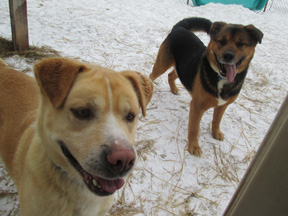
These two brothers are big, cuddly, handsome boys. They are full brothers and are about 4 years old. They are friendly, playful and housebroke. If you have a yard and a big heart and would like to adopt these two together, it would make their life complete. They are Beagle/Husky mixes. I can just imagine hanging out on the couch with them, watching TV and staying warm.
Easter is coming up fast. Please be certain you can commit to any chicks, ducks, lambs, goats or rabbits you may acquire. They have special needs that must be met. Talk it over with our local feed stores. They will be more than happy to help you decide how much effort and cost it will be. It is always rewarding when it is done responsibly. Spring is here!
Back to Top
| Last modified: 03/23/2015 |
© |
|



















